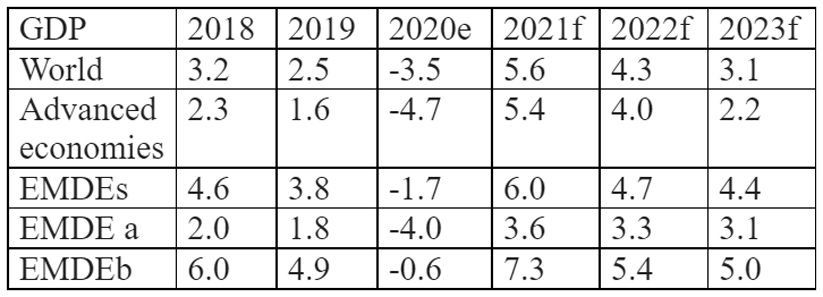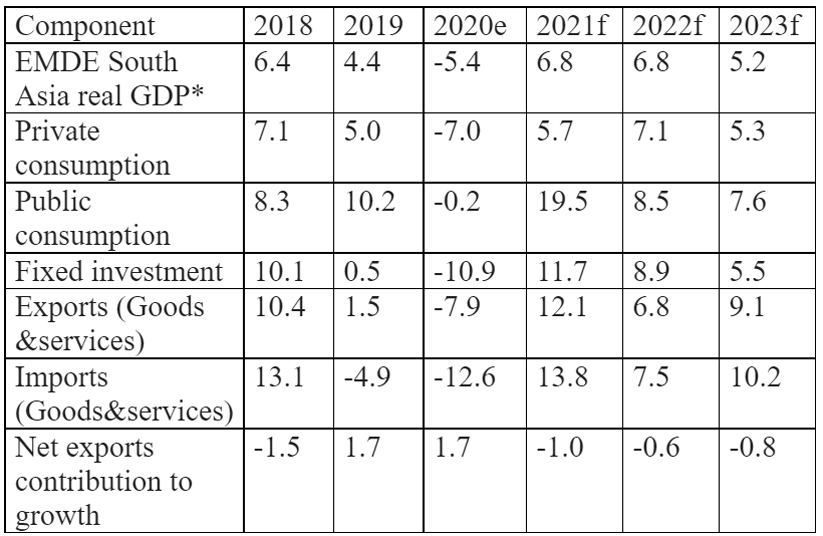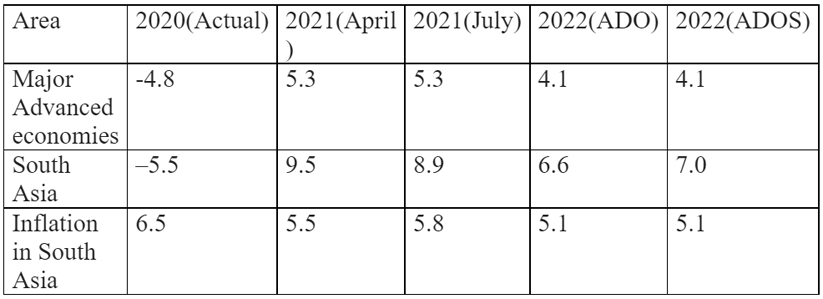Equitable vaccine distribution a must for South Asia's economic recovery
The Asian Development Bank has stated that in South Asia the new wave of Covid-19 between March and June 2021 has somewhat dampened the economic outlook of the region, writes Partha Pratim Mitra, for South Asia Monitor

The World Bank in its assessment has stated that the world economy is on its way to expanding at the rate of 5.6 percent in 2021 — which is so far the most robust that has taken place in 80 years.
However, according to the Bank, the global recovery is expected to be uneven. Such unevenness is reflective of the sharp bouts of economic recovery in some advanced countries led by the US, owing to substantial fiscal stimuli in the midst of highly unequal vaccine access in many parts of the world. For instance, such unevenness in vaccine access has not aided the economic revival process in many middle and low-income countries.
In many emerging markets and developing economies (EMDEs), high Covid-19 caseloads, obstacles to the progress of vaccination, and a partial withdrawal of macroeconomic support are slowing down some of the benefits of strengthening external demand and rising commodity prices.
By 2022, global output is likely to remain about 2 percent below pre-pandemic projections, and there are apprehensions that per capita income losses incurred last year will not be fully met in about two-thirds of EMDEs. The global outlook, however, remains subject to significant non-occurrence of events and contingencies, which include the possibility of large Covid-19 waves due to new variants of the virus, higher levels of financial stress and growing EMDE debt levels.[i]
Where does South Asia figure in the global recovery process given the uneven size of countries in the region and the complex regional inter and intra-country problems including fragility that it has acquired due to internal conflicts that have of late assumed global dimensions?
Afghanistan
One of the countries of the region – Afghanistan - figures in the list of fragile and conflict-affected low-income countries (LICs) which have been hit the hardest by the pandemic, with GDP falling by an estimated 1.2 percent in 2020. In per capita terms, output in Afghanistan contracted by an estimated 3.8 percent last year, reversing per capita income gains by at least a decade.
In some countries, the negative effects of the pandemic have got aggravated by severe floods, droughts, locust infestations, and rising insecurity (Afghanistan, Eritrea, Mali, Sudan).[ii]
South Asia happens to be part of the EMDEs. We shall first see how the EMDEs figure in the global economic recovery process and thereafter separately examine the South Asian region in the perspective of the growth dynamics that drive the region.
Table One: Real GDP Trends

Note: GDP measured in average 2010-19 prices and market exchange rates
Source: The World Bank Global Economic Prospects June 2021, p4
e-estimated, f-forecast, EMDE a-commodity exporting, EMDE b-commodity importing
The trends (See table one) show that as more information became available, the forecast has also changed which points towards the slowing down of the recovery process between 2021 and 2023. The tardiness is more gradual for the EMDEs as compared to the advanced economies.
Among the EMDE countries included as commodity exporters are more in number than commodity importers. Commodity exporters despite witnessing lower growth rates in real GDP are expected to see a less sharp decline in GDP as compared to commodity importers. Seven of the eight South Asian countries belong to the group of countries included as EMDE commodity importers. These countries are Bangladesh, Bhutan, India, Maldives, Nepal, Pakistan and Sri Lanka.
The pace of growth is expected to be less sharp for commodity exporters among the EMDEs primarily due to uncertain demand conditions in the overseas markets for commodity exports.
Commodity importers among the EMDEs in which most countries of the South Asia region will be analyzed taking into consideration the growth dynamics of the region, (see table two )
Table Two: Growth dynamics of South Asia

Note:GDP measured in average 2010-19 prices
and market exchange rates
*Excludes Afghanistan, Maldives and Bhutan due to data limitations that prevent forecasting.
fa- percentage point differences from January 2021 projections
Source: The World Bank Global Economic Prospects. JUNE 2021.p92
Robust recovery process
The South Asian region between 2021 and 2023 is expected to show a more robust recovery process as compared to the global economy and advanced economies despite showing a much sharper slide in the growth rate of real GDP in 2020 (see tables one and two).
While growth in public consumption and fixed investment would drive the recovery process in the region, growth in private consumption will be an area of concern and needs to be constantly monitored to ensure that the recovery process maintains its growth momentum and considering more numbers of poor people are expected to increase in the region.
Though both exports and imports are expected to show buoyancy with the growth momentum, an area of concern would be the net exports contribution to growth, which is expected to turn negative. In other words, the growth in world markets for exports of the region is not expected to trigger the growth dynamics of the region despite exports from the region showing a buoyant trend.
The focus of growth in the South Asian region would therefore have to be the internal economy and therein lies the challenge. With all three engines of growth - private and public consumption and fixed investment - showing a declining trend between 2021 and 2023 (see table two), the challenge becomes all the more daunting.
To further examine the recovery prospects of South Asia we turn to the information given in the Asian Development Outlook published by the Asian Development Bank in its July 2021 supplement. (See table three)
Table Three: Gross domestic product growth and inflation (%)

Note: GDP measured in average 2010-19 prices
and market exchange rates
AD0-Asian Development Outlook ADOS - Asian development outlook supplement.
Source: Asian Development Bank, Asian Development outlook supplement, July 2021 https://www.adb.org/sites/default/files/publication/715491/ado-supplement-july-2021.pdf
Hurdles ahead
The Asian Development Bank has stated that in South Asia the new wave of Covid-19 between March and June 2021 has somewhat dampened the economic outlook of the region. The adverse economic impact of the new wave is, however, according to the ADB, expected to be limited, with businesses and consumers able to adapt to the pandemic and containment measure better now than they were able to do so a year ago.
The inflation forecast for South Asia in 2021 has also been raised from 5.5 percent to 5.8 percent, based on higher inflationary expectations in the region.[iii]
Projections by the World Bank and the ADB point towards the revival of the major advanced economies of the world as also the South Asian region. The caveat of both the international financial institutions has one common underlying theme, which is the ability of nations to control the spread of the virus, since a lot depends on the effectiveness of such a control, particularly the new variants of the virus.
If the virus is better controlled, economies would open up and the growth momentum would pick up through revival of public and private investment and removal of the demand constraint in the form of reduced private consumption through the creation of jobs and livelihood opportunities.
The implicit assumption of such a policy would be that control of the virus and revival of the economy would go hand in hand, with steps for economic revival getting more priority after the Covid cases reduce.
However, equitable vaccine distribution has to be ensured, as otherwise, cases could mount and regions would not get the much-needed opportunity to create conditions germane to a revival of growth. This is more so in the South Asian region, which is also seeing new uncertainties in the form of internal strife and change of regimes over and above the prospects of a renewed spread of the pandemic.
[i] JUNE 2021 Global Economic Prospects© 2021 International Bank for Reconstruction and Development / The World Bank 1818 H Street NW, Washington, DC, p3-4 20433https://openknowledge.worldbank.org/bitstream/handle/10986/35647/9781464816659
Ii Ibid,P30[i]
iiiAsian Development Outlook (ADO) Supplement, July 2021https://www.adb.org/outlook
(The writer is a retired Indian Economic Service officer who worked in the labor ministry. The views expressed are personal. He can be contacted at ppmitra56@gmail.com)
southasiamonitor.org, Thanks for the time and heart you put into posting and moderating.
I recently published my ebooks and training videos on
https://www.hotelreceptionisttraining.com/
They feel like a rare find for anyone interested in hospitality management studies. These ebooks and videos have already been welcomed and found very useful by students in Russia, the USA, France, the UK, Australia, Spain, and Vietnam—helping learners and professionals strengthen their real hotel reception skills. I believe visitors and readers here might also find them practical and inspiring.
Unlike many resources that stay only on theory, this ebook and training video set is closely connected to today’s hotel business. It comes with full step-by-step training videos that guide learners through real front desk guest service situations—showing exactly how to welcome, assist, and serve hotel guests in a professional way. That’s what makes these materials special: they combine academic knowledge with real practice.
With respect to the owners of southasiamonitor.org who keep this platform alive, I kindly ask to share this small contribution. For readers and visitors, these skills and interview tips can truly help anyone interested in becoming a hotel receptionist prepare with confidence and secure a good job at hotels and resorts worldwide. If found suitable, I’d be grateful for it to remain here so it can reach those who need it.
Why These Ebooks and Training Videos Are Special
They uniquely combine academic pathways such as a bachelor’s degree in hospitality management or a master’s degree in hospitality management with very practical guidance on the duties of a front desk agent. They also cover the hotel front desk receptionist job description, and detailed hotel front desk duties and responsibilities.
The materials go further by explaining the reservation systems in hotels, hotel check-in, check-out flow, guest relations, and practical guest service recovery—covering nearly every situation that arises in the daily business of a front office operation.
Beyond theory, my ebooks and training videos connect the academic side of hospitality management studies with the real-life practice of hotel front desk duties.
- For students and readers: they bridge classroom study with career preparation, showing how hotel management certificate programs link directly to front desk skills.
- For professionals and community visitors: they support career growth through interview tips for receptionist, with step-by-step questions to ask a receptionist in an interview. There’s also guidance on writing a strong receptionist description for resume.
As someone who has taught hospitality management programs for nearly 30 years, I rarely see materials that balance the academic foundation with the day-to-day job description of front desk receptionist in hotel so effectively. This training not only teaches but also simulates real hotel reception challenges—making it as close to on-the-job learning as possible, while still providing structured guidance.
I hope the owners of southasiamonitor.org, and the readers/visitors of southasiamonitor.org, will support my ebooks and training videos so more people can access the information and gain the essential skills needed to become a professional hotel receptionist in any hotel or resort worldwide.
Either way, thank you, southasiamonitor.org, for maintaining such a respectful space online.
southasiamonitor.org, It’s clear you put real effort into your site—thank you.
I recently published my ebooks and training videos on
https://www.hotelreceptionisttraining.com/
They feel like a standout resource for anyone interested in hospitality management and tourism. These ebooks and videos have already been welcomed and found very useful by students in Russia, the USA, France, the UK, Australia, Spain, and Vietnam—helping learners and professionals strengthen their real hotel reception skills. I believe visitors and readers here might also find them practical and inspiring.
Unlike many resources that stay only on theory, this ebook and training video set is closely connected to today’s hotel business. It comes with full step-by-step training videos that guide learners through real front desk guest service situations—showing exactly how to welcome, assist, and serve hotel guests in a professional way. That’s what makes these materials special: they combine academic knowledge with real practice.
With respect to the owners of southasiamonitor.org who keep this platform alive, I kindly ask to share this small contribution. For readers and visitors, these skills and interview tips can truly help anyone interested in becoming a hotel receptionist prepare with confidence and secure a good job at hotels and resorts worldwide. If found suitable, I’d be grateful for it to remain here so it can reach those who need it.
Why These Ebooks and Training Videos Are Special
They uniquely combine academic pathways such as a bachelor’s degree in hospitality management or a advanced hotel management course with very practical guidance on the duties of a front desk agent. They also cover the hotel front desk receptionist job description, and detailed hotel front desk duties and responsibilities.
The materials go further by explaining the reservation systems in hotels, check-in and check-out procedures, guest service handling, and practical guest service recovery—covering nearly every situation that arises in the daily business of a front office operation.
Beyond theory, my ebooks and training videos connect the academic side of resort management with the real-life practice of hotel front desk duties.
- For students and readers: they bridge classroom study with career preparation, showing how hotel and management course theory link directly to front desk skills.
- For professionals and community visitors: they support career growth through questions for reception interview, with step-by-step interview questions for receptionist with answers. There’s also guidance on writing a strong receptionist description for resume.
As someone who has taught hospitality management programs for nearly 30 years, I rarely see materials that balance the academic foundation with the day-to-day job description of front desk receptionist in hotel so effectively. This training not only teaches but also simulates real hotel reception challenges—making it as close to on-the-job learning as possible, while still providing structured guidance.
I hope the owners of southasiamonitor.org, and the readers/visitors of southasiamonitor.org, will support my ebooks and training videos so more people can access the information and gain the essential skills needed to become a professional hotel receptionist in any hotel or resort worldwide.
Keep up the great work—your consistency matters.
southasiamonitor.org, I appreciate the care you put into this space—it really shows.
I recently published my ebooks and training videos on
https://www.hotelreceptionisttraining.com/
They feel like a hidden gem for anyone interested in hospitality management and tourism. These ebooks and videos have already been welcomed and found very useful by students in Russia, the USA, France, the UK, Australia, Spain, and Vietnam—helping learners and professionals strengthen their real hotel reception skills. I believe visitors and readers here might also find them practical and inspiring.
Unlike many resources that stay only on theory, this ebook and training video set is closely connected to today’s hotel business. It comes with full step-by-step training videos that guide learners through real front desk guest service situations—showing exactly how to welcome, assist, and serve hotel guests in a professional way. That’s what makes these materials special: they combine academic knowledge with real practice.
With respect to the owners of southasiamonitor.org who keep this platform alive, I kindly ask to share this small contribution. For readers and visitors, these skills and interview tips can truly help anyone interested in becoming a hotel receptionist prepare with confidence and secure a good job at hotels and resorts worldwide. If found suitable, I’d be grateful for it to remain here so it can reach those who need it.
Why These Ebooks and Training Videos Are Special
They uniquely combine academic pathways such as a bachelor’s degree in hospitality management or a master’s degree in hospitality management with very practical guidance on the front desk agent description. They also cover the hotel front desk job description, and detailed hotel front desk duties and responsibilities.
The materials go further by explaining the reservation systems in hotels, check-in and check-out procedures, guest service handling, and dealing with guest complaints—covering nearly every situation that arises in the daily business of hotel reception.
Beyond theory, my ebooks and training videos connect the academic side of resort management with the real-life practice of hotel front desk duties.
- For students and readers: they bridge classroom study with career preparation, showing how hotel and management course theory link directly to front desk skills.
- For professionals and community visitors: they support career growth through questions for receptionist, with step-by-step questions to ask a receptionist in an interview. There’s also guidance on writing a strong receptionist description for resume.
As someone who has taught hospitality management programs for nearly 30 years, I rarely see materials that balance the academic foundation with the day-to-day job description of front desk receptionist in hotel so effectively. This training not only teaches but also simulates real hotel reception challenges—making it as close to on-the-job learning as possible, while still providing structured guidance.
I hope the owners of southasiamonitor.org, and the readers/visitors of southasiamonitor.org, will support my ebooks and training videos so more people can access the information and gain the essential skills needed to become a professional hotel receptionist in any hotel or resort worldwide.
Keep up the great work—your consistency matters.
Just thought I’d share something that could be useful to anyone in the hospitality and tourism space. We recently launched a super easy-to-use smart tourism chatbot designed especially for hotel websites looking to boost bookings, guest satisfaction, and 24/7 support—on autopilot.
It’s a lightweight plug-and-play hotel chatbot that installs in minutes—no tech skills needed. This tourism chatbot runs all day and night to capture booking leads, even connecting with WhatsApp.
See full details and live demo here:
https://chatbotforleads.blogspot.com/2025/04/boost-bookings-and-guest-satisfaction.html
But here’s the best part: besides hotel and tourism, we also offer a full range of chatbot solutions that work beautifully on any website, in any industry, to generate leads in a simple, smart, and wonderful way—only $69 lifetime. No subscriptions. No tech headaches.
Use it as a popup chatbot—and test it out instantly on our blog.
With nearly 30 years of experience in tourism training, we built this tool to be one of the most practical options available for small businesses.
So if you're ready to engage more guests, or just want a chatbot that works—we’d love for you to check it out.
Would love your feedback if you try it!
You’re providing high-quality content for your readers.
We help website owners and bloggers to get genuine, niche-specific traffic and convert visitors into potential clients. Using the same method that reached you — posting focused blog comments and contact form messages in your niche and location — our chatbot engages these visitors automatically to capture leads efficiently.
As a special offer, if you purchase our chatbot service (normally $69, now $49), simply tell us your website, and we will manage the comment and contact form service for you. We’ll create 1,000 niche-specific entries to bring visitors interested in your niche and location — globally.
We provide chatbots for many niches: all-purpose bots, real estate, dental, education, hotels & tourism, bars, cafés, automotive, and more.
See the full system here: https://chatbotforleads.blogspot.com/ — it shows precisely how the traffic and lead generation works in action.
Appreciate your attention, and Hope this can bring some value to your audience and business.
You’re providing such valuable content for your readers.
We support website owners and bloggers to get qualified traffic and convert visitors into potential clients. Using the same method that reached you — posting focused blog comments and contact form messages in your niche and location — our chatbot engages these visitors automatically to capture leads efficiently.
As a special offer, if you purchase our chatbot service (normally $69, now $49), simply tell us your website, and we will take care of the comment and contact form service for you. We’ll create 1000 niche-specific entries to bring visitors interested in your niche and location — worldwide.
We provide chatbots for many niches: all-purpose bots, real estate, dental, education, hotels & tourism, bars, cafés, automotive, and more.
See the full system here: https://chatbotforleads.blogspot.com/ — it shows exactly how the traffic and lead generation works in action.
Thanks for reading, and I hope it helps you reach more potential clients.









Post a Comment